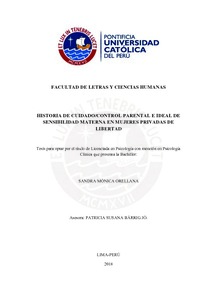| dc.contributor.advisor | Bárrig Jó, Patricia Susana | es_ES |
| dc.contributor.author | Orellana, Sandra Mónica | es_ES |
| dc.date.accessioned | 2018-06-15T17:50:51Z | es_ES |
| dc.date.available | 2018-06-15T17:50:51Z | es_ES |
| dc.date.created | 2018 | es_ES |
| dc.date.issued | 2018-06-15 | es_ES |
| dc.identifier.uri | http://hdl.handle.net/20.500.12404/12156 | |
| dc.description.abstract | La presente investigación tuvo como objetivo explorar y describir la relación entre la
historia de cuidado y control parental y el ideal de sensibilidad materna en mujeres
privadas de libertad en un establecimiento penitenciario de régimen cerrado en Lima.
Además, se buscó describir los comportamientos de cuidado y control parental, como
también las conductas más y menos características de una madre idealmente sensible.
Finalmente, se realizó comparación entre mujeres madres y no madres acerca de los ideales
maternos sensibles. Participaron 38 mujeres madres y no madres de entre 18 y 46 años de
edad (M=29.97, D.E.=7.35). Para la evaluación se utilizó el Maternal Behavior for
Preschoolers Q-Sort (MBPQS) de Posada, Moreno y Richmond (1998), en la modalidad
de reporte de ideales y el Parental Bonding Instrument de Parker, Tupling y Brown (1979).
Los resultados obtenidos mostraron que las mujeres participantes, se acercan al estilo
parental denominado vínculo ausente o débil (Parker et al., 1998). Además, reportaron que
una madre sensible ideal se caracteriza por ofrecer apoyo a la base segura y la contribución
a la interacción armoniosa. Por otro lado, expresaron que no es una característica materna
sensible asumir con irritabilidad e impaciencia las demandas del hijo/a. En cuanto a la
comparación del ideal sensible materno en madres y no madres, no se encontró diferencias
significativas. Finalmente, en referencia al objetivo general, no se encontró relación entre
la historia de cuidado/control parental y el ideal de sensibilidad materno. | es_ES |
| dc.description.abstract | The aim of this research was to explore and describe the relationship between the history
of parental childcare and control and the ideal maternal sensitivity in incarcerated women
in a high-security prison in Lima, Peru. In addition, this research describes the
characteristics of parental childcare and control. We will also describe behaviors of care
and control of an ideal sensitive mother. Finally, there were comparisons between the ideal
maternal sensitivity between women mothers and non-mothers. For this purpose, 38
women were evaluated: mothers and non-mothers, between the ages of 18 and 46.
(M=29.97, D.E.=7.35). For the evaluation, we used the Maternal Behavior for
Preschoolers Q-Sort (MBQS) by Posada, Moreno and Richmond (1998), in the reality of
ideal reports, and the Parental Bonding Instrument by Parker, Tupling and Brown (1979).
The results obtained showed that participating mothers approach the parental style called
absent or weak link (Parker et al., 1998). In addition, they reported that an ideal sensitive
mother is characterized by offering the secure-base support and the contribution to
harmonious interaction. On the other hand, they expressed that it is not a sensitive maternal
characteristic to assume with irritability and impatience the demands of the child. The
comparison of the maternal sensitive ideal in mothers and non-mothers, did not show
significant differences. Finally, in relation with the general objective no significant
differences were found in the relationships between the histories of parental care and
control and the ideal sensitive mother. | es_ES |
| dc.language.iso | spa | es_ES |
| dc.publisher | Pontificia Universidad Católica del Perú | es_ES |
| dc.rights | Atribución-NoComercial-SinDerivadas 2.5 Perú | * |
| dc.rights | info:eu-repo/semantics/openAccess | es_ES |
| dc.rights.uri | http://creativecommons.org/licenses/by-nc-nd/2.5/pe/ | * |
| dc.subject | Sensibilidad | es_ES |
| dc.subject | Maternidad | es_ES |
| dc.subject | Prisioneras--Perú--Investigaciones | es_ES |
| dc.title | Historia del cuidado/control parental e ideal de sensibilidad materna en mujeres privadas de libertad | es_ES |
| dc.type | info:eu-repo/semantics/bachelorThesis | es_ES |
| thesis.degree.name | Licenciado en Psicología Clínica | es_ES |
| thesis.degree.level | Título Profesional | es_ES |
| thesis.degree.grantor | Pontificia Universidad Católica del Perú. Facultad de Letras y Ciencias Humanas | es_ES |
| thesis.degree.discipline | Psicología Clínica | es_ES |
| renati.advisor.dni | 09391905 | |
| renati.advisor.orcid | https://orcid.org/0000-0003-4685-5760 | es_ES |
| renati.discipline | 313026 | es_ES |
| renati.level | https://purl.org/pe-repo/renati/level#tituloProfesional | es_ES |
| renati.type | http://purl.org/pe-repo/renati/type#tesis | es_ES |
| dc.publisher.country | PE | es_ES |
| dc.subject.ocde | https://purl.org/pe-repo/ocde/ford#5.01.00 | es_ES |






